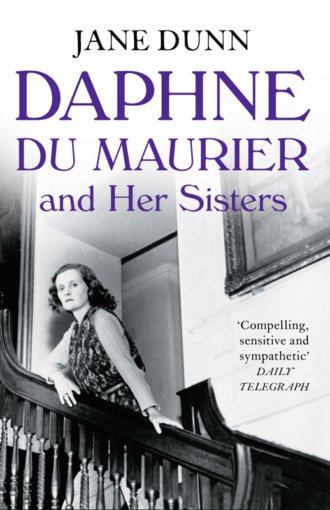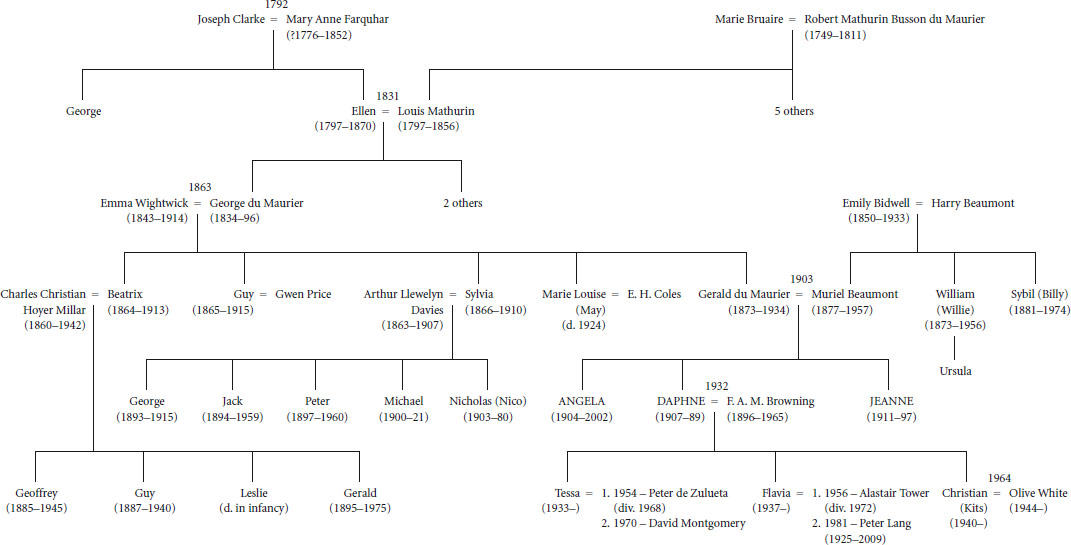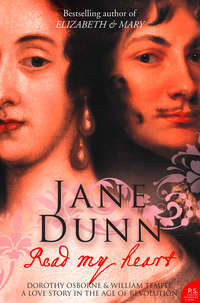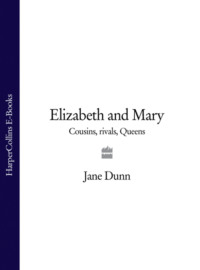
Полная версия
Daphne du Maurier and her Sisters

DAPHNE
DU MAURIER
AND HER SISTERS
The Hidden Lives of
Piffy, Bird and Bing

JANE DUNN

Dedication
In celebration of all sisters,
and particularly mine:
Kari, Izzy, B, Trish and Sue
(and our outnumbered brothers Marko and Andy)
CONTENTS
TITLE PAGE
DEDICATION
DU MAURIER FAMILY TREE
PREFACE
1. The Curtain Rises
2. Lessons in Disguise
3. The Dancing Years
4. Love and Losing
5. In Pursuit of Happiness
6. Set on Adventure
7. Stepping Out
8. A Transfiguring Flame
9. Fruits of War
10. A Mind in Flight
11. A Kind of Reckoning
12. Heading for Home
AFTERWORD
PICTURE SECTION
FOOTNOTES
NOTES
ILLUSTRATIONS
SELECT BIBLIOGRAPHY
ACKNOWLEDGEMENTS
ABOUT THE AUTHOR
BY THE SAME AUTHOR
COPYRIGHT
ABOUT THE PUBLISHER
DU MAURIER FAMILY TREE

PREFACE

But it is very foolish to ask questions about any young ladies – about any three sisters just grown up; for one knows, without being told, exactly what they are – all very accomplished and pleasing, and one very pretty. There is a beauty in every family. It is a regular thing. Two play on the piano-forte, and one on the harp – and all sing – Or would sing if they were taught – or sing all the better for not being taught – or something like it.
JANE AUSTEN, Mansfield Park
JANE AUSTEN UNDERSTOOD about sisters. Mansfield Park and Persuasion seethe with them. Pride and Prejudice is as much about the affection, rivalry and vexation of sisters as it is about the complicated progress of true love for Jane and Elizabeth with Bingley and Darcy. Jane Austen shared a bedroom with her elder sister Cassandra all her life and they relied entirely on each other’s love and support. There is something infinitely touching about their relationship, and tragic too, for Cassandra lived on alone for twenty-eight years after her younger sister died.
In biography, families are the soil out of which character grows, and one of the richest composts is the relationship of sisters. They are ever fascinating, cast from the same mould yet struggling for difference, brought up in the same family yet each with a childhood unique to herself. For good and ill, the sibling bond lasts a lifetime, longer than any other relationship with parents, partners or children, and it is sisters who weave the most complex webs of love and loyalty, resentment and hurt. Adults can turn sisters against each other by cruel comparisons and overt favouritism, as happened in the lifelong feud, continuing into their nineties, between the star of the film of Daphne du Maurier’s Rebecca, Joan Fontaine, and her elder sister Olivia de Havilland, who landed the starring role in Daphne’s other great blockbuster, My Cousin Rachel. When sisters’ affections turn sour it can be deadly, for each knows the family’s secrets. More often, however, sisters are a foil and support to each other, a source of inspiration and close conspiracy; the safety net encouraging flight and breaking a fall.
Daphne du Maurier was fascinated by the Brontë siblings and identified with them all, but she jokingly hoped she and her sisters might emulate Charlotte, Emily and Anne one day, if only she could get her artist sister to write too. A bevy of sisters is more than the sum of its parts and it is to this protean relationship that I, as a biographer, like to turn. The first pair I explored was Virginia Woolf and her artist sister Vanessa Bell. This was an archetypal relationship of passionate dependence and rivalry, ultimately transfigured into self-sacrificing love, remarkably well delineated in the sisters’ own letters, Virginia’s novels and Vanessa’s portraits. I followed Virginia & Vanessa with other biographies that featured prominently sisters, daughters and female cousins. Then, with this book, another set of sisters drew my attention.
For most of my life I had been unaware that Daphne du Maurier, author of so many stories that had gripped my young self, had any sisters at all. To find that she had two, her elder sister Angela a writer like herself, and her younger, Jeanne, a painter, piqued my interest. To have a sister’s fame so eclipse the others was psychologically interesting. Even more intriguing, however, was to find how different were the characters and lives of all three du Maurier sisters, yet how strongly imprinted with family values, bonded to each other in their desire to live in close proximity in Cornwall – with Jeanne eventually settling over the border in Dartmoor.
In writing the story of Vanessa Bell and Virginia Woolf I had set out to try and convey, as far as possible, their lives and thoughts in their own words. I hoped to do the same with the du Maurier sisters and was gratified to find how many of Daphne’s letters existed, and how candid and full of interest they were. She had also written a memoir of herself when young, based on the early diaries that she subsequently embargoed. Daphne’s letters are so rich, expressive and funny that they rival Nancy Mitford’s for wit and brio. All three du Maurier sisters wrote excellent letters: conversational, lively with news and comment and a great deal of humour, but Angela’s and Jeanne’s have been largely destroyed or withheld.
Angela was a prolific writer of letters all her long life. She had many friends and acquaintances, but when she was old it seems that she wrote to her closest friends and asked them to destroy her letters. She had already burnt all her love letters, she explained to one of her past lovers, whose letters she had decided to keep. She also could not bring herself to burn her love poems to various important women in her life. For Angela, her deepest feelings and what made her happy in life, were in conflict with her desire to keep up appearances. She learnt early to dissemble to her parents. This conflict became more marked as she grew older, living within a close community in Fowey in Cornwall, where she was held in respect as ‘Miss Angela’, and attached to an Anglo-Catholic Church unsympathetic to any nonconformity in faith or life.
Despite this attempt to obscure her true self, two extrovert autobiographies, if read carefully, are full of hints of a larger life, a more independent and courageous attitude to love, than one might ever suspect from the conventional face she chose to present to the world. She did not want to be known for her guise as maiden aunt who had missed out on love. There had been much more to her than her Pekinese dogs and the roles of dutiful daughter, dependable friend and stalwart of Church and community. I hope this exploration of her life is in keeping with at least one aspect of her family’s ethos, for the sisters were much influenced by their own father’s view that a biography is only worth doing if it attempts to tell the truth without evasion or pretence. Daphne boldly followed this precept with her own memoir of her father, soon after his death, shocking some of his old friends with her temerity.
Whereas following Angela’s clues have led me on an intriguing journey of dead-ends and surprising revelations, the search for Jeanne has been blocked from the beginning of my researches. Her lifelong partner, the intellectual and prize-winning poet Noël Welch, still lives in their exquisite house on Dartmoor with the best collection of Jeanne’s paintings, all her papers and her memories. Now in her nineties, she has been adamantly set against any biography of the sisters, despite writing her own insightful piece on them for The Cornish Review nearly forty years ago. There are vivid glimpses of Jeanne in other people’s letters and memoirs. In the few letters that have surfaced, an expressive, amusing, highly creative voice rings out through the years as freshly as when they were written.
The du Maurier girls could not have been more closely brought up. They were consciously sheltered from the contamination of school; for them there was no escape where, freed from controlling adults, they might speak of taboo subjects like sex and God and money. Largely lacking outside friends, the sisters were thrown on each other’s company and their own imaginations in a way that seems peculiarly intense compared to modern childhoods, with the ready distractions of the wider world. Moreover, they never quite managed to cast off the bonds of their family: the tentacles of the past spread into every part of their adult lives. Their influence on each other as children was potent and undiluted and it both held them back and spurred them on. For this reason I have dwelt at some length on their shared early life at Cannon Hall in London’s Hampstead.
In this, the last generation to be named du Maurier, as daughter after daughter was born, it was hoped that at least one of them would have been a son, to ensure the continuation of the family genius and name. As mere girls, however, they would have to do as best they could. It was good indeed, but could it ever be good enough? The superlatives that surrounded their parents and forebears entered the romance of their family inheritance. ‘These things added to our arrogance as children,’ was how Daphne described the effect in her scintillating recreation of a theatrical childhood in her novel The Parasites: ‘as babies we heard the thunder of applause. We went about, from country to country, like little pages in the train of royalty; flattery hummed about us in the air, before us and within us was the continual excitement of success.’1 Edwardian parental influence and du Maurier expectation was paramount. But given the distinctiveness of their upbringing, the sisters relied on each other for education and entertainment, with little change of view contributed by outside friends or adults who were not in the theatre. This hot house amplified their importance in each other’s lives; family dynamics are seldom more complex and long-lived than in the love and rivalry of sisters.
‘You have the children, the fame by rights belongs to me,’2 Virginia Woolf famously wrote to her elder sister, the painter Vanessa Bell, expressing an age-old sense of natural sisterly justice. But this fragile balancing act was overthrown in the du Maurier family. For as it transpired, Daphne, the middle sister, not only had the fame but also the children, the beauty, the money, the dashing war-hero husband; she won all life’s prizes, her fame so bright that it eclipsed, in the eyes of the world, her two sisters and their creative efforts as writer and painter. However, Daphne did not value these prizes. Nothing mattered as much to her as the flight of her extraordinary imagination that animated some of the most haunting stories of the twentieth century.
Her elder sister Angela, more extrovert and expressive, had the emotional energy for children and wrote of her longing to have been a mother. Certainly fame too promised to bring her more pleasure than it ever did to Daphne, who recoiled from publicity and the importuning of fans. Angela, eclipsed as she was, nevertheless came so close to claiming a share of the limelight; when she turned to singing she did not even get to first base as an opera singer, although her love of opera was to last a lifetime and she tried yet failed to join her parents’ profession and become an actor. Insecure and easily discouraged, she quickly abandoned her youthful dreams of a life of performance as enjoyed by her parents. Instead, her emotional nature found an outlet in fiction, a highly regarded aspect of the family business thanks to the success of their grandfather the artist George du Maurier, whose late career as a novelist brought him transatlantic fame.
Soon after the publication in 1928 of Radclyffe Hall’s notorious novel, The Well of Loneliness, a plea for understanding ‘sexual inversion’ in women, Angela began writing her own first novel, The Little Less. Given the damning prejudices of the time, together with her father’s powerful influence and horror of homosexuality, Angela showed surprising courage – even revolutionary zeal – in exploring the bold theme of a woman’s love for another. Like The Well of Loneliness, Angela’s novel was not a great literary work, but it was a brave one and would have brought her a great deal of notice and some riches. Publication and attention would have established her as a novelist to watch and encouraged her to continue, and grow. Instead, she was met by rejection from publishers scared of another scandal. Her tentative flame of independence was snuffed out and she was left demoralised, perhaps even ashamed, for she had thrown light on a taboo subject and been silenced. She put the manuscript away, returned to the distraction of a busy social life and did not write again for almost a decade.
Meanwhile, Daphne had been writing a few startling short stories since she was a girl and then, sometime later in 1929, had begun her first novel. The Loving Spirit, a rather more conventional adventure story, was spiced with what was to become the characteristic du Maurier sense of menace. This too was not a particularly good book but it was a much safer subject and easily found a publisher in 1931. Daphne was launched as a writer on a spectacular career that powered her through four books in five years to the darkly atmospheric Jamaica Inn and then, two years later in 1938, her creative prodigy Rebecca stormed to bestseller status. The momentum was now entirely with her. Daphne’s writing career, financial security and reputation were all made by the phenomenal success of Rebecca, and the haunting Hitchcock film that followed. The eclipse of her sisters was complete.
Jeanne, seven years younger than Angela, had also made a bold move that went against the powerful family ethos. She had tried her hand at music and was a fine pianist all her life, but her real love was painting. Hers was a family brought up to decry anything modern in the arts. The French Impressionists, the English Post-Impressionists, whose exhibition in London in 1910 had caused uproar among polite society, all horrified their father Gerald du Maurier. He was vocal in his derision of any art after the mid-nineteenth century and his opinions were held in Mosaic regard by his adoring family. ‘Daddy loathed practically everything that was modern. He hated modern music, modern painting, modern architecture and the modern way of living … Gauguin horrified him I do remember,’ Angela wrote, adding, ‘I’m not at all sure it’s a good thing to be as impressed by one’s parents’ ideas and opinions as I was by Daddy’s.’3
Angela was not alone. All the sisters were in awe of their father’s opinion on most things and Angela and Daphne never came to appreciate twentieth-century art. This made it all the more remarkable, but also painful for her, that Jeanne made her career as a painter, not of conventional, narrative, realistic pictures that her family might have appreciated, but of quiet, contemplative, modernist works. Her family did not value her art enough to hang it with pleasure on their walls, although her paintings were considered good enough by the art establishment to be bought by at least one public gallery. Jeanne seemed not to long for children, neither did she court fame, but her painting was the mainspring of her life and her immediate family’s lack of appreciation of her work was a kind of denial too.
The intriguing threads of inheritance, character, family mythology and circumstance combine with early experience to create the pattern of a life. It is in childhood that these elements make their deepest impression. Here can be found possible reasons for Angela’s lack of perseverance that became a lasting regret: ‘I have always been an easily discouraged person … I had not the “guts” to start again writing’.4 Inheritance and familial experiences gave Daphne the contrary commitment; imagination and writing were the things most worthwhile in life. It helped that her talent was encouraged by her doting Daddy who saw so much in his favourite tomboy daughter to remind him of his own father. ‘[He] told me how he had always hoped that one day I should write, not poems, necessarily, but novels … “You remind me so of Papa,” he said. “Always have done. Same forehead, same eyes. If only you had known him.”’5
In childhood Jeanne found the seeds of her later independence. Her mother’s favourite and perhaps the most honest and down-to-earth of them all, she was the youngest sister who chose a discredited style of painting as her life’s work and managed to live openly until her death with a woman poet as her partner, despite the oft-expressed antipathy of her father towards people like her.
The sense the family had of being glamorous, exceptional and blessed with French blood was reinforced by the private language they shared. This was a highly visual and entertaining creation that bound them together as a tribe and kept out pretenders. Daphne’s fascination with the Brontës and Gondal, their imaginary world, brought the verb ‘to Gondal’ into the sisters’ lexicon, meaning to make-believe or elaborate upon. Nicknames too were a du Maurier habit. Angela became various forms of ‘Puff’, ‘Piff’ and ‘Piffy’; Daphne was ‘Tray’, ‘Track’ or ‘Bing’; and Jeanne was ‘Queenie’ or ‘Bird’.
Exploring Daphne’s character and work in the context of her sisters, means she appears in a quite different light from the one that shines on her as the solitary subject of a life. She was shyly awkward and intransigent, a girl who escaped into her own imaginary world, where she was supreme. Intent on wresting control over her destiny she thereby influenced the lives of others, not least her sisters’.
In introducing her two much less famous sisters, I hope this book draws them from the shadows. I like to think that Angela, who longed for more notice during her lifetime and dreamed of having a film made from at least one of her stories (Daphne had ten – the unforgettable Rebecca, The Birds and Don’t Look Now among them), would have been delighted to be rediscovered, her books read, possibly even inspiring a belated dramatisation. Where Daphne controlled her universe, Angela, at the mercy of her emotions, seemed to be buffeted by hers. Unfocused when young, and wilting under pressure, her youth was marked by humiliations and missed opportunities, while she was intent on the pursuit of love. Later she discovered a remarkable courage to tackle in her novels and her life injustice in matters of the heart, and to live as unconventionally as she pleased. As she aged, however, the constraining bonds of her Edwardian upbringing tightened around her once more.
A little light shed on Jeanne might also lead to a wider audience for her art, with paintings taken out of storage in small galleries and hung on the walls, for new generations to appreciate. The largest public collection is at the Royal West of England Academy in Bristol, where the quiet atmospheric beauty of her works rewards the eye with a spare, unsentimental vision. She was perhaps the most solid and least flighty of them all. Jeanne was always the honest, boy-like sister and did not apparently struggle with questions of identity or her role in life. When she decided what she wanted to do, all her energy was committed to it, unlikely to be deflected by emotion or propriety.
Much has been written on every aspect of Daphne du Maurier’s work and life. Margaret Forster’s impressive biography published nearly twenty years ago remains the authority on her life, but there are other essential contributions from Judith Cook’s Daphne: A Portrait of Daphne du Maurier and Oriel Malet’s Letters from Menabilly. Her daughter Flavia Leng’s poignant memoir adds another layer of understanding. Daphne’s writing attracted penetrating analysis in Avril Horner and Sue Zlosnik’s Daphne du Maurier: Writing, Identity and the Gothic Imagination, and in Nina Auerbach’s personal take on the themes of Daphne’s fiction in Daphne du Maurier, Haunted Heiress. The rewarding mix of The Daphne du Maurier Companion, edited by Helen Taylor, and Ella Westland’s Reading Daphne, add their own layers of meaning. There is also a highly successful yearly literary festival at Fowey, established to honour Daphne’s close connection and imaginative contribution to that part of south-east Cornwall.
In this book I do not set out to write a full biography of each sister; nor have I the space to analyse their individual works in any depth, although I have discussed them when they offer extra biographical or psychological insights to the story. I have considered the du Maurier sisters side by side, as they lived in life. This adds a new perspective to the characters of each, as they evolve through the tensions and connections of ideas and feelings that flow within any close relationship. Most marked is how much the opinions and experiences of one sister find their way into the work of another. In their fiction particularly, Angela and Daphne each used aspects of their sisters’ lives to animate her own work. But all the du Maurier sisters drew on their unique childhood, a past that was always present, bringing light and dark to their lives and work.
1

The Curtain Rises
Coats off, the music stops, the lights lower, there is a hush. Then up goes the curtain; the play has begun. That is why I’m going to begin this story ‘Once upon a time …’
ANGELA DU MAURIER, First Nights
TO BE BORN a du Maurier was to be born with a silver tongue and to become part of a family of storytellers. To be born the last of the du Mauriers, as the three sisters would be, was to be born in a theatre with the sound of applause, the smell of greasepaint, and the heart attuned to drama, tension and a quickening of the pulse. The du Mauriers were in thrall to myths of their ancestors. Even the romantic name that meant so much to them was an embellishment on something more mundane. As soon as they were old enough to understand, Angela, Daphne and Jeanne du Maurier realised they were special and had inherited a precious thread of creative genius that connected them to their celebrated forebears.
Although Daphne did marry, all three sisters evaded the conventional roles of wife and mother and rose instead to the challenge of living up to their name, a name they never relinquished. Two sisters expressed themselves through writing and the third through paint. The du Maurier character was volatile and charming, inflated with fantasy and pretence; characteristically they hung their lives on a dream and found little solace in real life once the romance had gone.
These three girls inherited a name famous on both sides of the Atlantic: their grandfather George du Maurier was a celebrated illustrator, Punch cartoonist and bestselling novelist. His most famous creation was Trilby and this sensational novel enhanced his fame and made him rich: it gave the world the ‘trilby’ hat and made his anti-hero, the mesmerist Svengali, part of the English language as a byword for a sinister, controlling presence. It was his first novel, Peter Ibbetson, however, that impressed his granddaughters most, insinuating into their own lives and imagination its haunting theme that by ‘dreaming true’ one could realise the thing one most desired. The sisters attempted in their different ways to practise this art in life and incorporate the idea in aspects of their work.






